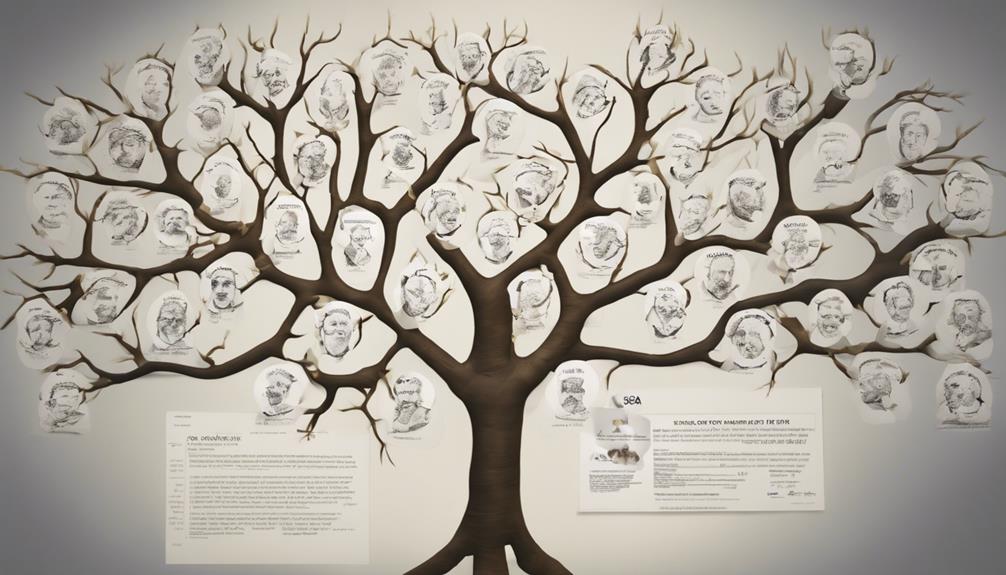When it comes to sleep apnea, genes are crucial in determining how our airways are shaped, which in turn affects our breathing while we sleep. Certain genetic factors can make some individuals more susceptible to developing sleep apnea, with genes linked to obesity also increasing the risk of this condition. By examining genetic markers, healthcare providers can offer more personalized and effective care for each individual. Customized treatments based on genetic testing can greatly improve the management of sleep apnea. Further research into the genetic aspect of sleep apnea can lead to better solutions for achieving restful sleep.
Key Takeaways
- Genetic factors impact craniofacial structure, affecting airway passages in sleep apnea.
- Specific genes may predispose individuals to obstructive sleep apnea.
- Variants in genes related to obesity influence the risk of sleep apnea.
- Understanding genetic markers aids in assessing and managing sleep apnea effectively.
- Personalized treatment approaches based on genetic testing improve outcomes for sleep apnea patients.
Genetic Influences on Craniofacial Structure
Genetic influences on craniofacial structure greatly impact the development of sleep apnea. Our unique genetic makeup can play an important role in determining the shape and size of our facial bones, which in turn can affect the airway passages in our throat. Certain genes related to craniofacial development may predispose individuals to obstructive sleep apnea, a condition where the airway becomes partially or completely blocked during sleep. This narrowing of the airway due to genetic factors can increase the risk of breathing disruptions, leading to symptoms like snoring and daytime fatigue.
Understanding how genetic variations influence craniofacial structure is essential in identifying individuals at higher risk for obstructive sleep apnea. By recognizing these genetic risk factors early on, healthcare providers can implement personalized approaches to managing and treating sleep apnea. This knowledge allows for tailored interventions that address the specific anatomical factors contributing to each individual's sleep apnea, ultimately improving their quality of sleep and overall well-being.
Obesity Genes and Sleep Apnea Risk

Obesity genes play a significant role in influencing the risk of developing sleep apnea.
These genetic factors can affect how fat is distributed in the body, which in turn can contribute to the development and severity of sleep apnea.
Individuals with specific genetic variants related to metabolism and adipose tissue may have a higher susceptibility to experiencing sleep apnea.
Obesity Genes Impact
In the intricate web of connections between obesity and sleep apnea lies an important factor: the impact of genetic variants on one's risk of developing obstructive sleep apnea. Genetic factors associated with obesity genes can influence the likelihood of developing obstructive sleep apnea (OSA). These genetic variants may lead to changes in how fat is distributed in the body, affecting airway function and potentially increasing the risk of OSA. Understanding these links can help tailor treatment and assess risks for individuals with both obesity and sleep apnea. Family history of obesity-related genes plays a crucial role in this genetic puzzle, highlighting the significance of genetic screening and management strategies.
| Genetic Factors | Obesity Genes | Obstructive Sleep Apnea (OSA) |
|---|---|---|
| Influence risk of OSA | Impact body fat distribution | Contribute to airway function changes |
Sleep Apnea Connection
Exploring the relationship between body fat distribution and the risk of sleep apnea reveals a significant impact of genetic variants associated with obesity on individuals' susceptibility to this sleep disorder. Obesity genes can increase the likelihood of developing obstructive sleep apnea (OSA) by influencing body fat distribution and respiratory function during sleep.
Understanding the pivotal basis of sleep disorders like OSA helps healthcare providers tailor treatment approaches for better outcomes. By recognizing the genetic link between obesity and sleep apnea, personalized interventions can be designed to address specific risk factors and improve overall sleep quality.
Genetic factors play an essential role in determining an individual's predisposition to OSA, highlighting the importance of genetic assessments in managing sleep disorders effectively.
Impact of Upper Airway Function
Our upper airway, the pathway through which we breathe, is essential for maintaining healthy oxygen flow during sleep.
The genetic makeup influencing the shape and structure of our airway can impact how we breathe while resting.
Variations in genes controlling muscle tone and breathing can play a significant role in determining our risk of developing obstructive sleep apnea.
Airway Anatomy Significance
Understanding how airway anatomy influences upper airway function is pivotal in unraveling the complexities of sleep apnea. Genetic factors can impact the shape and structure of the airway, potentially leading to conditions like obstructive sleep apnea. Certain individuals may have airway characteristics that make them more prone to breathing interruptions during sleep. Variations in craniofacial structure can also play a role in airway collapse while sleeping. By delving into the genetic basis of airway anatomy, personalized strategies for managing sleep apnea can be developed. To better comprehend this relationship, let's explore the significance of airway anatomy in the context of sleep apnea:
| Airway Anatomy Significance | Impact in Sleep Apnea |
|---|---|
| Shape and Structure | Essential role in development |
| Genetic Factors | Influence risk of condition |
| Craniofacial Variations | Impact on upper airway |
Breathing During Sleep
Breathing patterns during sleep are influenced by the function of the upper airway, highlighting its pivotal role in the development and management of sleep apnea. The upper airway's anatomy, including its shape and structure, can impact how we breathe while asleep.
Genetic factors play a significant role in the function of upper airway muscles, contributing to the risk of sleep apnea. Weak throat muscles or abnormalities in facial bone structure may also affect how well the upper airway functions during sleep.
Understanding how upper airway function influences breathing patterns is essential for effectively managing sleep apnea. By recognizing the importance of the upper airway in regulating breathing during sleep, individuals and healthcare providers can work together to address and treat sleep apnea more effectively.
Hereditary Component in OSA

Studying the hereditary component in obstructive sleep apnea (OSA) reveals a significant influence of specific genetic factors on the risk of developing the disorder. Family studies suggest that OSA can run in families, indicating a genetic predisposition. Certain genetic factors related to craniofacial structure, obesity, and upper airway function can increase the likelihood of developing OSA. Individuals with a family history of OSA are at a higher risk of experiencing the condition themselves. This highlights the importance of understanding the hereditary component of OSA to better predict and prevent its occurrence.
Research shows that genetic factors play an essential role in the development of OSA. By identifying these genetic markers, healthcare providers can tailor personalized treatment approaches to manage the condition more effectively. This emphasizes the significance of considering family history and genetic factors when evaluating and treating individuals with OSA. Understanding the genetic puzzle of OSA can lead to more targeted and successful interventions for those affected by this sleep disorder.
Personalized Treatment Approaches

Exploring genetic markers in sleep apnea enables us to tailor personalized treatment approaches to address individual risk factors effectively. When considering personalized treatment for sleep apnea based on genetic factors, it's important to take the following steps:
- Identifying Genetic Variants: Understanding the specific genetic variants related to craniofacial structure, obesity, and upper airway function that contribute to an individual's susceptibility to sleep apnea is vital for developing targeted interventions.
- Assessing Family History: Examining a patient's family history of sleep apnea can provide valuable insights into genetic predispositions, guiding healthcare providers in customizing treatment strategies accordingly.
- Choosing Treatment Options: Personalized treatment approaches for sleep apnea may include lifestyle modifications, CPAP therapy, surgical interventions, or oral appliances, depending on the genetic factors identified in an individual.
- Utilizing Genetic Testing: Genetic testing and analysis play a significant role in creating tailored interventions for managing sleep apnea and enhancing overall sleep health. By leveraging genetic information, healthcare professionals can offer more precise and effective treatment options for patients with sleep apnea.
Genetic Factors in OSA Mechanisms

Have genetic factors been identified as key contributors to the mechanisms underlying obstructive sleep apnea (OSA)?
Yes, indeed. Studies have shown that there's a hereditary component in OSA, meaning that genetics can play a significant role in the development of this condition. Genetic factors related to craniofacial structure, obesity, and upper airway function can influence the risk of developing OSA. If there's a family history of OSA, the likelihood of an individual developing the disorder increases. Moreover, certain environmental and lifestyle factors, such as alcohol consumption, smoking, and sedentary habits, can exacerbate the condition, especially in individuals already genetically predisposed. Interestingly, disturbances in sleep patterns, similar to triggers of sundowners syndrome, which is often associated with confusion and agitation in the evening, can also worsen the symptoms of obstructive sleep apnea (OSA). Addressing both genetic and external factors is key to managing and reducing the severity of OSA.
Frequently Asked Questions
Is There a Genetic Link to Sleep Apnea?
Yes, there is a genetic link to sleep apnea. Family studies show a higher prevalence among relatives, suggesting genetic factors play a role. Understanding these connections can lead to personalized treatments for those at risk.
What Is the Sleep Pattern of Someone With Sleep Apnea?
When someone has sleep apnea, they may experience interruptions in breathing during sleep. These pauses, known as apneas, lead to disrupted sleep patterns, loud snoring, and daytime fatigue. Sleep studies like polysomnography help diagnose this condition.
Can You Reverse Sleep Apnea?
Yes, we can reverse sleep apnea through various methods like CPAP therapy, weight loss, oral appliances, and surgery. By addressing underlying causes and adopting healthy sleep habits, we can effectively treat and even reverse this condition.
Is Sleep Apnea Considered a Disability?
Yes, sleep apnea can be considered a disability if it greatly impacts daily activities like sleeping or breathing. Qualifying for disability benefits may be possible with medical evidence showing the condition's severity and effects on functioning.
Conclusion
To sum up, the genetic puzzle of sleep apnea has been unraveled, shedding light on the various factors that contribute to this condition. Understanding the genetic influences on craniofacial structure, obesity genes, and upper airway function is essential in developing personalized treatment approaches for individuals with sleep apnea.
With this new knowledge, healthcare professionals can provide more targeted and effective care, leading to improved outcomes for patients. The impact of genetics on sleep apnea is truly remarkable and opens up new possibilities for treatment.









